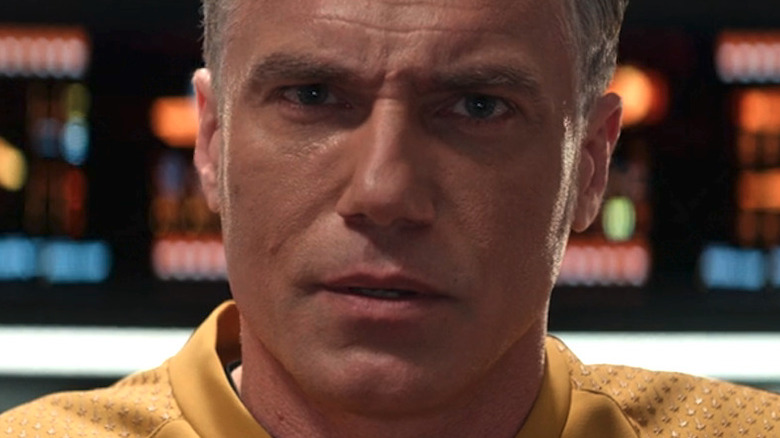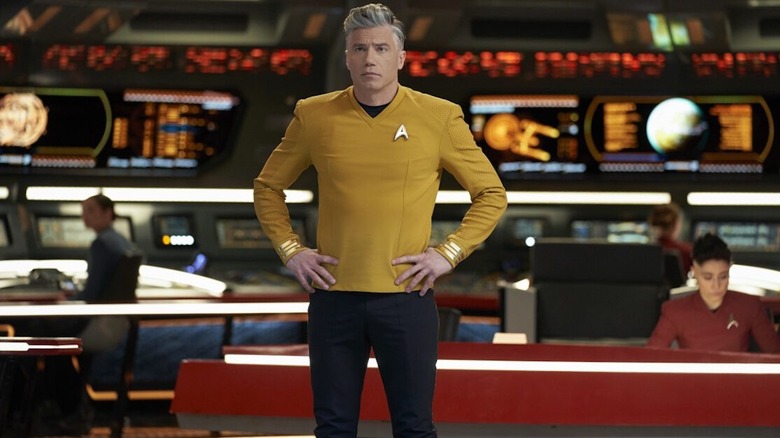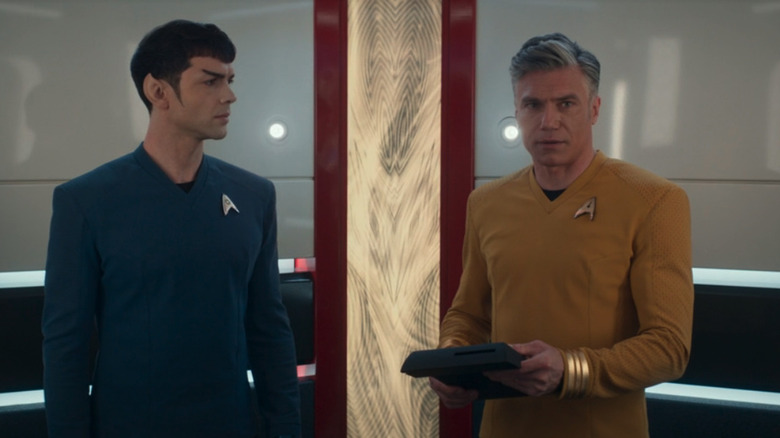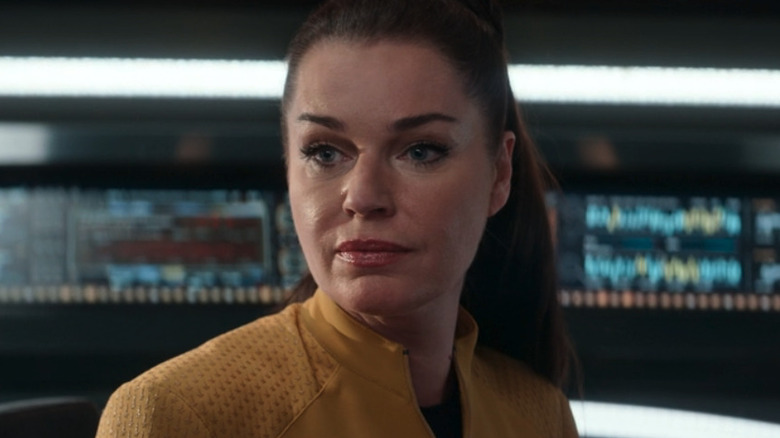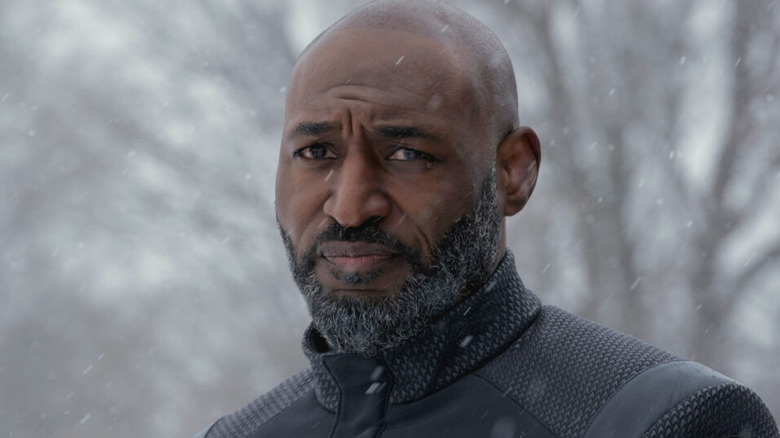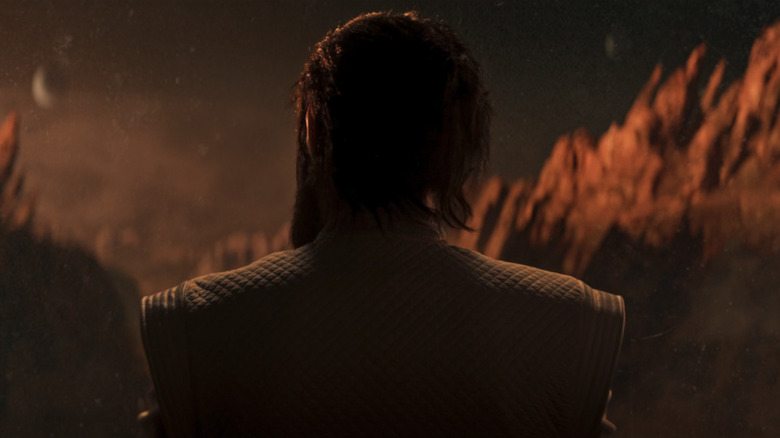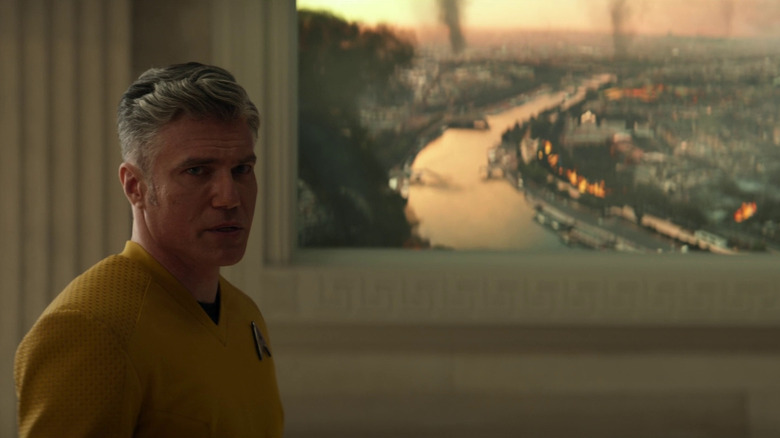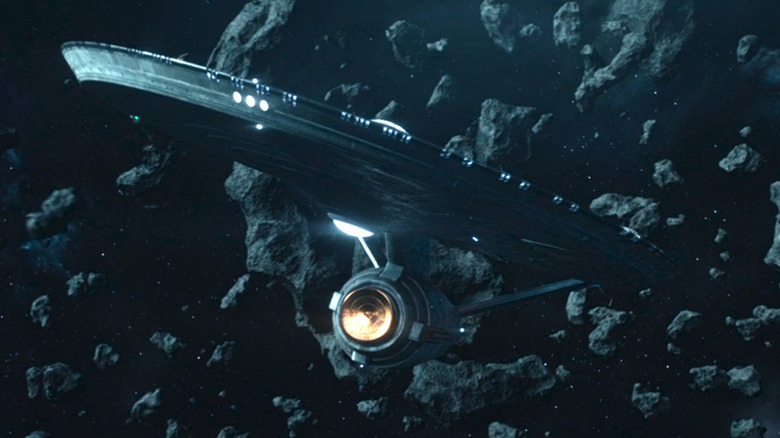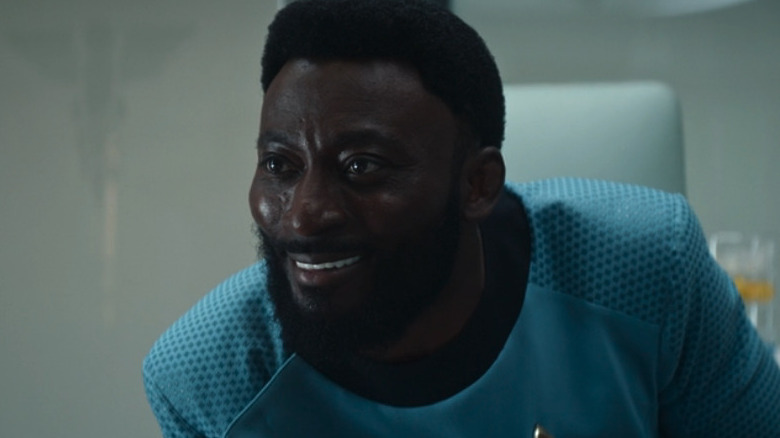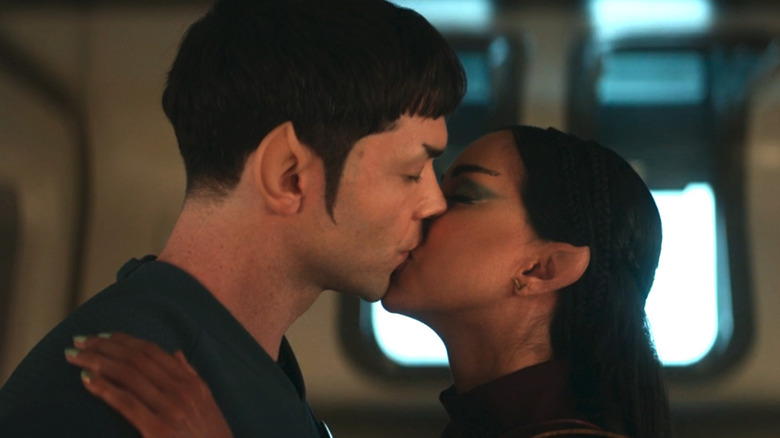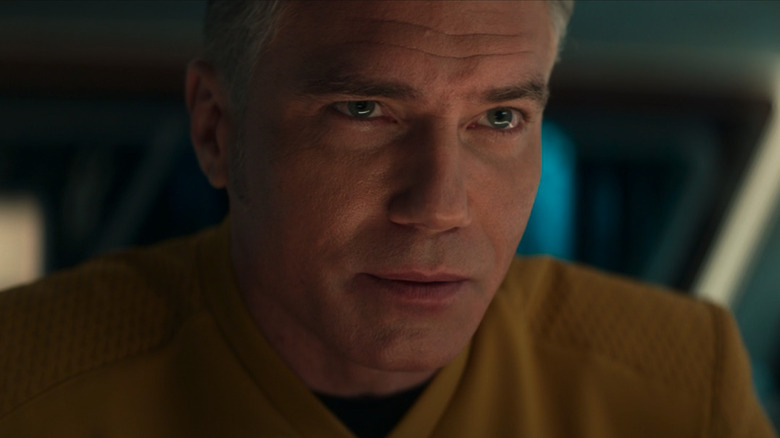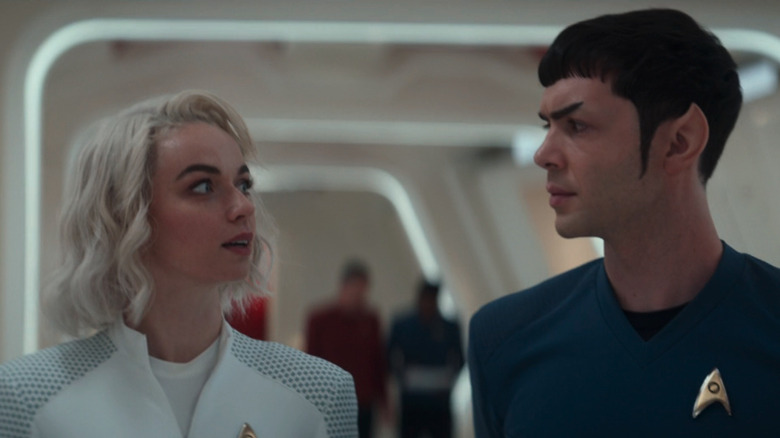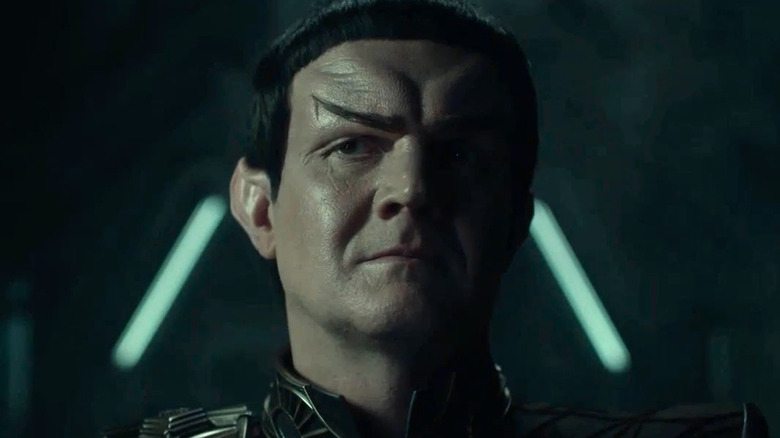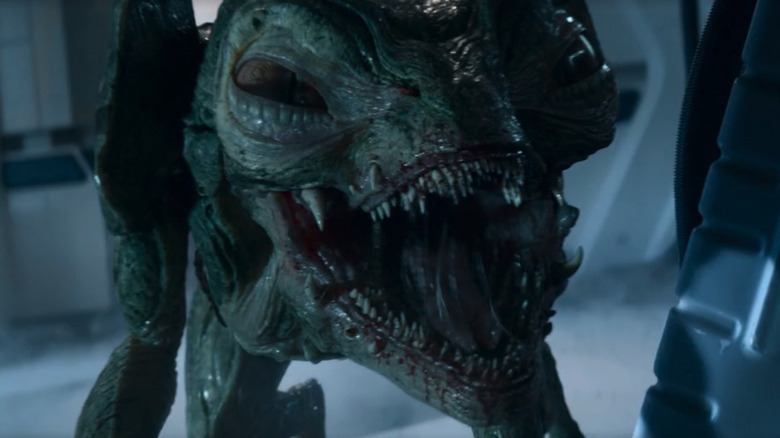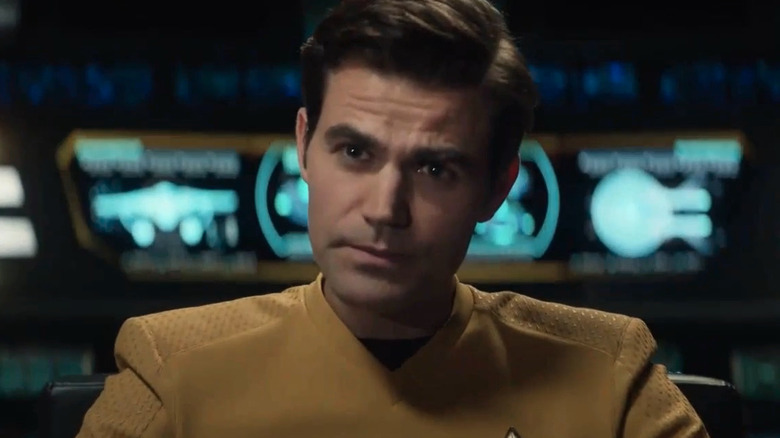Burning Star Trek Questions Finally Answered By Strange New Worlds
Every new episode, every new movie, and every new story in the "Star Trek" franchise inevitably leaves us with questions that we will ponder over, sometimes for decades. When the critically acclaimed "Star Trek" series "Strange New Worlds" launched in 2022, Trekkies finally got answers to some of these questions.
Set nearly a decade before Kirk commanded the Enterprise, the series features several characters who we've seen before. Captain Pike, who originated in the first "Star Trek" pilot "The Cage," leads the line in "Strange New Worlds." He's joined by a host of well-known characters, such as Uhura and Spock. Recurring favorites like Nurse Chapel and M'Benga are also main players in the show. Set on the classic U.S.S. Enterprise, "Strange New Worlds" explores the unseen backstories of our favorite characters, expands on established alien races, and resolves some of the biggest "Star Trek" canon questions.
So adjust your lateral sensor array, recalibrate your inertial dampeners, and load forward torpedo bays, because these are some of the burning "Star Trek" questions answered by "Strange New Worlds."
What was the Enterprise like before Kirk?
When the first "Star Trek" series launched in 1966, all fans knew was Captain Kirk and his stalwart crew: Mr. Spock, Dr. McCoy, Lt. Sulu, Uhura, Chekov, and others. But we soon learned about a former captain, Christopher Pike. We quickly realized that the U.S.S. Enterprise was a ship with history, with perhaps decades of service long before James T. Kirk was in command. But what were those years like? Plenty of expanded universe novels and comic books looked back at what kind of leader Pike was, while Trekkies often invented stories for the days before Kirk in high quality fan films. After decades of "Star Trek" establishing itself as one of the biggest and broadest sci-fi franchises around, we finally got a look at what the Enterprise was like in its earlier days.
In "Strange New Worlds," we learn that while Pike is a no-nonsense captain, he believes in force only as a last resort. He is more than the stoic, grim officer we saw in "The Cage," someone who has a real bond with his crew. We also get to meet several new Enterprise crew members — Lt. Hemmer, an Aenar engineer; Ortegas, a ride-or-die operations officer; and security chief La'An Noonien-Singh, a descendent of an early 21st century Earth tyrant. After decades of wondering, "Strange New Worlds" finally gives us a glimpse into a missing piece of the Enterprise puzzle, a fascinating look into an important era in franchise canon that was previously a major blindspot.
How close were Spock and Pike?
Pike was first introduced to viewers in the "Star Trek: The Original Series" episode "The Menagerie," shown as a former captain of the Enterprise who had served with Mr. Spock in the years before Kirk. Pike is disfigured and mute, having been seriously injured in a training exercise gone wrong. While the bulk of the episode flashes back to the never-before-seen first pilot episode "The Cage," it's in the present that Spock risks his entire career by commandeering the Enterprise to take his former commanding officer to a forbidden planet where he can live out his remaining days in peace. Spock shows a personal loyalty that borders on family, demonstrating that his relationship with Pike is as close as (or perhaps even closer than) the one he shares with Captain Kirk.
The relationship between Spock and Pike went unexplored for decades following "The Menagerie," but it finally got some attention in "Strange New Worlds." Early in Season 1 it becomes clear that their relationship goes beyond professional, as Pike is shown to be a confidante and friend to his Vulcan science officer, offering him counsel in personal matters. In the season finale, "A Quality of Mercy," Spock notes that Pike has sacrificed his future not just to avoid a war, but to save the Vulcan from the same dark fate he is destined for. Tied together with the events of "The Menagerie," Spock's theft of the Enterprise can now be seen as him repaying that debt.
Who is Number One?
In "Star Trek" canon there are few characters that have inspired as much gossip and fan theorizing as Number One, Pike's right-hand woman in the original pilot. Owing partly to her being a high-ranking female officer in an era when that was not the norm, and partly due to her being played by creator Gene Roddenberry's eventual real-life wife Majel Barrett, fans have clamored to know more about this enigmatic first officer. After featuring in flashbacks in "The Menagerie," Number One was not seen on screen until Season 2 of "Star Trek: Discovery," where she was played by big-screen star Rebecca Romijn. She only appeared in a handful of scenes, but in "Strange New Worlds," Number One took center stage, even receiving an episode that explored her backstory.
We finally learned her real name — Una Chin-Riley — as well as her origins as a genetically modified Illyrian, both concepts drawn from a 1989 novel, "Vulcan's Glory." A fierce, by-the-book officer with a reputation for seriousness, she's considered one of the finest in the fleet according to Pike. But her background as an Illyrian is a secret, as genetic modification is banned in the Federation. In the "Strange New Worlds" Season 1 finale, when her true nature is discovered by Starfleet, she is arrested, suggesting that the reason she disappeared from "Star Trek" history is a prison sentence. It's a huge cliffhanger, and we have a feeling there's much more to the story.
Who was the first captain of the Enterprise?
Another rarely talked-about character from "Star Trek" history is Robert April, the first captain of the Enterprise. April became known to audiences in "The Counter-Clock Incident," a 1974 episode of "Star Trek: The Animated Series." He pops up as an aging Admiral who visits the Enterprise and in turn saves the ship from catastrophe.
When "Star Trek" returned to live-action, most of the animated episodes were deemed non-canonical. No mentions of April would be made until "Star Trek: Discovery" over 40 years later, where he is cited as one of Starfleet's most decorated captains and noted as Pike's commanding officer on the Enterprise when he was serving as the first officer. In "Star Trek: Strange New Worlds," we meet April for the first time in live-action canon, played by actor Adrian Holmes. An Admiral at this point in time, he orders Pike back to command the Enterprise in the opening episode, and in "Spock Amok," he is seen serving as a high-ranking Federation official on Starbase 1.
Set up as a recurring character, the fact that Holmes was seemingly aged up with a salt-and-pepper beard in his appearance suggests we may get flashbacks to his time as captain of the Enterprise in future seasons.
Will the franchise ever acknowledge Sybok?
Before Michael Burnham in "Star Trek: Discovery," there was another retconned sibling of Mr. Spock, introduced in the much-maligned "Star Trek V: The Final Frontier." In that film, we met the resident Vulcan's illegitimate half-brother Sybok. A full-blooded Vulcan who rejected logic and led a cult of fanatical followers, Sybok was shown to possess powers of introspection and inner healing. But since that time, there hasn't been a single reference to the character. Even with his adopted sister, his half-brother, and his father being major characters in recent years (and with different versions of Spock appearing in "The Next Generation" and in three big-budget reboot films), Sybok has been conspicuous by his absence, especially for a franchise that loves Easter eggs and references.
"Strange New Worlds" finally gave us the answer to the burning question "Where the heck is Sybok?" in the 7th episode of the debut season, "The Serene Squall." In the episode, the villainous Captain Angel is using the Enterprise and Spock as bartering chips to have her imprisoned husband freed from a Vulcan rehabilitation center. In the closing moments of the episode, the Vulcan in question is revealed to be none other than Sybok. While the tone of the scene suggests a possible return for the character, it's also just as possible that his appearance was simply a way of putting fan questions about the character to rest.
When were the Eugenics Wars and World War III?
Mentioned numerous times in "Star Trek: The Original Series," the Third World War was used largely as a cautionary tale. Like the Earth/Romulan war of the late 21st century (also mentioned repeatedly in canon but never depicted on screen), World War III has never been fully detailed, with little concrete information about the conflict made available to fans. The only thing we knew for sure was that it occurred before Earth's first contact with Vulcans.
Meanwhile, Earth's Eugenics Wars — first mentioned in the "TOS" episode "Space Seed" — were said to have taken place in the 1990s, with Khan Noonien-Singh being a major malevolent figure during that time. But as the 1990s came and went in real life, the dates and circumstances surrounding the Eugenics Wars became blurred in "Star Trek" canon. Books and comics in the expanded universe often attempted to explain it away, as part of the appeal of "Star Trek" is that it ostensibly takes place in the future of our very real world.
In the series premiere of "Strange New Worlds," the franchise finally retconned both wars and rolled them together. Pike, in a speech to a political delegation on an alien world, describes Earth's Third World War as a devastating global conflict that arose out of what was first called the Second Civil War and then the Eugenics Wars. In the end, total nuclear Armageddon engulfed the planet.
Is the Enterprise the Federation flagship?
The U.S.S. Enterprise has always been thought of as the best ship in the Federation fleet, though this wasn't officially confirmed in "The Original Series." It wasn't until "The Next Generation" that the Enterprise-D was presented as the Federation's flagship, leading many to believe that the crew were the best and brightest that Starfleet had to offer. Still, the notion that the Enterprise was the flagship of the fleet was hotly debated for decades — until the question was finally put to rest in "Star Trek: Strange New Worlds."
Towards the end of the episode "Ghosts of Illyria," Dr. M'Benga makes note of the fact that he is the Chief Medical Officer on the flagship of the Federation, a prestigious and enviable position that gives him access to the best technology and the brightest minds. Now, after more than six decades, we can declare definitively that the classic U.S.S. Enterprise is as revered and important a ship in-universe as it is in the hearts and minds of fans.
Who is Dr. M'Benga?
Many fans were surprised to see that Dr. M'Benga was going to feature in "Star Trek: Strange New Worlds" when the cast list was first announced. In "Star Trek: The Original Series," M'Benga was a minor character, appearing just twice in the show's three-year run as an underling of chief medical officer Dr. Leonard McCoy. Additionally, in the original "Star Trek" pilot "The Cage," the ship's chief surgeon was Boyce, an older, cantankerous Starfleet veteran. As such, many had suspected that it would be Boyce and not M'Benga in the new series, with Trekkies fan-casting the likes of Jeffrey Combs for the part.
Instead, M'Benga returns as the ship's CMO, and it's revealed that he has a close personal friendship with Captain Pike as well. But what's most compelling is his dramatic personal story: We learn that his daughter Rukiya suffers from a debilitating terminal disease, and to keep her alive, he has been storing her in the transporter buffer. His hope is that, aboard the Enterprise, he may encounter a strange new world that possesses the key to a cure. In the end, Rukiya gets her cure, but at great cost to her father.
Still, more questions remain about M'Benga, considering he was not the CMO aboard the Enterprise during "TOS." What is it that got him demoted? Perhaps Season 2 will provide the answer.
What was the relationship between Spock and T'Pring like?
It likely came as a surprise to viewers in 1967 when, in the now-classic episode "Amok Time," we were introduced to the emotionless Spock's wife, a Vulcan woman named T'Pring. In that episode, Spock is compelled to return to his home planet thanks to his seven-year mating cycle (referred to as the pon-farr), but when he arrives, he finds T'Pring uninterested in bonding. Instead, T'Pring has chosen for her betrothed to undergo the rite of kal-if-fee, a brutal hand-to-hand fight — and she chooses Captain Kirk to clash with him in a battle to the death.
Ultimately it is revealed that T'Pring had taken another lover while Spock was aboard the Enterprise and was looking for a way out of their marriage. Though little indication is given at the time as to the nature of their relationship, many had presumed that Spock and T'Pring were not passionate lovers, rather a pair of Vulcans in a strictly arranged relationship. But in "Strange New Worlds" their relationship is explored heavily, and we learn that it is quite the opposite. Spock and T'Pring hold what seems to be a genuine affection for each other — well, as genuine as Vulcans can get — and it is Spock's commitment to Starfleet that has gotten in the way of the relationship.
We also meet a younger version of Stonn — T'Pring's Vulcan lover from "Amok Time" — who is revealed for the first time to be her professional colleague, suggesting that their illicit affair may begin in the coming days.
Can Pike change his destiny?
When Pike made his first re-appearance in Season 2 of "Star Trek: Discovery," his adventure culminated in a trip to the Klingon monastery on Boreth where he was given a glimpse into his future. In this vision, Pike discovers that he will be horribly disfigured in a tragic accident and forced to live out his days immobile and mute. Though fans have known this for decades, it came as a shocking revelation for Pike, forcing us to wonder: If he knows his destiny, why can't he seek a way to change it, and alter "Star Trek" history?
Well, "Star Trek: Strange New Worlds" doesn't just answer this question, it makes it the crux of Pike's story throughout the entire debut season. Haunted by his nightmarish vision, he hesitates to return to the captain's chair and seeks counsel from Number One. He questions his fitness as a leader and wonders if knowing his fate will make him hesitant or even reckless. In the finale, Pike finally decides that he will change his future, and we're finally given our answer as to why he never does.
In "A Quality of Mercy," Pike attempts to avert the accident, but in doing so creates an alternate future where the Federation becomes drawn into a costly war with the Romulans. In the incident that sparks the war, his friend and science officer Spock is the one who gets horribly disfigured, and it's then that Pike realizes that to save himself he has to doom many more. In the end, Pike accepts his fate, and we learn why "Star Trek" history played out the way it did.
Why did Chapel crush so hard on Spock?
Back in the 1960s, the original "Star Trek" series had few romantic relationships depicted, and none between its main cast members. The closest the series came to a love affair among the main characters was recurring character Nurse Chapel (then played by Majel Barrett, who had previously starred as Number One) and science officer Mr. Spock. But this was always portrayed as a one-sided affair. Nurse Chapel had what appeared to be little more than a crush on the Vulcan lieutenant, whose emotionless personality rejected her playful come-ons. At the time, fans saw this as exactly that — an innocent and unrequited crush. But the question has always remained, was the relationship — such as it was — perhaps less one-sided than it appeared? And why exactly was Chapel so enamored with him?
In "Strange New Worlds," nurse Chapel is a series regular alongside Spock, and the show wastes no time in making it clear that the young transfer medical student has eyes for the Vulcan. Playfully flirting at first, her feelings grow deeper as the season progresses. But there also seems to be an affection on Spock's side, and it appears that the series is setting up a bigger love story between them. Spock becomes a genuine and heartfelt friend that Chapel is drawn to, while their romantic ruse in "The Serene Squall" adds plenty of passion to her desire.
Romulans and the mystery of Romii
Among the greatest villains in "Star Trek" history, the Romulans made their first appearance in Season 1 of "The Original Series," during the episode "Balance of Terror." That iconic episode would eventually form the basis for the "Strange New Worlds" Season 1 finale, "A Quality of Mercy," and in that same episode, the series would answer a long-standing question about the race's twin homeworlds.
In the original episode, an apparent miscommunication between the writers and the graphics department led Kirk to reference their dual worlds as "Romulus" and "Remus," while the star chart shown on the viewscreen labeled them as "Romulus" and "Romii." Over the years, "Star Trek" has largely ignored the on-screen typo, continuing to reference the two worlds as Romulus and Remus. But a star chart in "A Quality of Mercy" shed new light on the mythology.
The chart in question shows the two worlds as "Romulus/Remus" and "Romii." It would seem that either Romulus and Remus are two names for the same world, or, perhaps more likely, they are indeed the twin planets shown close together, with Romii being a third, unrelated world that stands as part of their interstellar empire. Whatever the case, it's the first time "Star Trek" has attempted to reconcile the discrepancy in "Balance of Terror," and it made sense to do it in "A Quality of Mercy," an episode that essentially replays the events of that "TOS" episode.
Are the Gorn really vicious monsters?
An all-time sci-fi classic, the "TOS" episode "Arena" saw Captain Kirk match wits with a Gorn — a lizard-like alien warrior — for the fate of their respective fleets. Depicted as ruthless and vicious, Kirk learns to fear the monstrous green reptile man, and in doing so learns a valuable lesson in understanding and empathizing with your enemy. But the question has always remained: Are the Gorn truly as cruel and bloodthirsty as the episode implies? Making a surprise return in "Star Trek: Strange New Worlds," the answer to this one is an emphatic "yes."
First mentioned as part of security chief La'An's tragic backstory, the Gorn feed on human corpses and use the bodies of victims as breeding sacks. If that wasn't terrifying enough, a fleet of Gorn ships stalk the Enterprise in "Memento Mori," showing them no mercy. Like the Borg in "The Next Generation," the Jem'Hadar in "Deep Space Nine," or the Hirogen in "Voyager," it seems the Gorn were set to become the most bloodthirsty and unstoppable adversaries in "Strange New Worlds."
In the debut season's penultimate episode, "All Those Who Wander," we get our first glimpse at the reimagined Gorn — or their young, at least. Sickening, terrifying monsters, they fight for dominance, killing each other until only the strongest survive. By the days of Kirk, it seems their reputation as bloodthirsty monsters will have been well-earned.
Who was the better captain: Pike or Kirk?
Though it's a subjective question, fans have been wondering this one for decades, as Pike has become a legendary figure in "Star Trek" history despite barely being seen on screen. Meanwhile, Captain James T. Kirk has become one of the most famous, respected, and highly decorated captains ever, with fans debating if he is the best to ever wear the stripes.
When "Strange New Worlds" first began to take shape, many fans grew concerned that it might wipe away the glow of Kirk and show that his predecessor was an even greater captain. Of course, who is better will always be up for debate, but the "Strange New Worlds" Season 1 finale "A Quality of Mercy" made it clear that Kirk possessed at least some qualities that made him a more skilled and savvy commander. In the episode, Pike is thrust forward in time seven years to a period when Kirk is in command. But here, Pike commands the Enterprise — not Kirk.
Re-imagining the confrontation with the Romulans from "Balance of Terror," Pike's patient push for peace winds up thrusting the Federation into war. Though peace is always an admirable goal, the episode demonstrated that Kirk was a better commander in the Neutral Zone encounter, able to size up his enemy and know that a tactical response was called for. For better or worse, diehard Kirk fans can rest easy as their perception of him as the greatest captain in Starfleet history holds strong.
